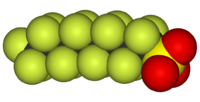
Photo from wikipedia
Urban estuaries receive large volumes of effluents from municipal wastewater treatment facilities containing numerous contaminants, such as pharmaceuticals residues. Water was sampled for 16 highly prescribed pharmaceuticals at 17 sites… Click to show full abstract
Urban estuaries receive large volumes of effluents from municipal wastewater treatment facilities containing numerous contaminants, such as pharmaceuticals residues. Water was sampled for 16 highly prescribed pharmaceuticals at 17 sites along the Long Island Sound (LIS) estuary located in the Northeastern U.S. Pharmaceutical concentrations were highest in western LIS, ranging from non-detect to 71 ng L-1 and declining steadily eastward, while river samples from four major tributaries ranged from non-detect to 83 ng L-1. Two tracers, sucralose and caffeine, accurately predicted pharmaceutical behavior in LIS while only sucralose was effective at the river sites. Sucralose also tracked well with the salinity gradient in LIS, exhibiting conservative behavior along the transect. Attenuation factors were determined for measurable pharmaceuticals and compared against sucralose to estimate the magnitude of decline in concentrations that may be attributable to in situ degradation and partitioning. The results demonstrate sucralose's effectiveness as a tracer of wastewater-borne contaminants under estuarine conditions.
Journal Title: Chemosphere
Year Published: 2019
Link to full text (if available)
Share on Social Media: Sign Up to like & get
recommendations!